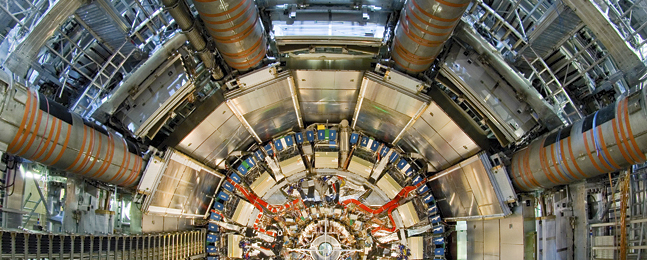A Primordial Soup

Courtesy of CERN
The ATLAS detector in the Large Hadron Collider.
by Laura Gardner
In the first few millionths of a second following the Big Bang, physicists believe the universe was so hot — more than two trillion degrees centigrade — that elementary particles known as quarks and gluons moved freely as part of a vast primordial and dense soup called a plasma. As the universe cooled, the theory goes, these specks of matter combined into the protons and neutrons that make up the matter we know today. But physicists have lacked evidence for this soupy condition in the early universe. That’s because recreating its dense conditions in the laboratory on a tiny scale has never been achieved. Until now.
Deep underground in a 17-mile circular tunnel outside of Geneva, Switzerland, an experiment known as ATLAS is running in the world’s largest particle accelerator, the Large Hadron Collider. ATLAS is attempting to reproduce the physical conditions that existed in the universe less than a billionth of a second after its birth in the Big Bang, by colliding protons at extraordinarily high energy. The Brandeis high-energy group has collaborated on the ATLAS experiment since it was on the drawing board 16 years ago.
In November, the group, comprising physicists Craig Blocker, Larry Kirsch, Hermann Wellenstein and Jim Bensinger, in collaboration with other scientists worldwide working on the ATLAS experiment, garnered evidence for the dense, soupy quality of the early universe.
“We have completed a successful first year of running the ATLAS experiment,” says Bensinger. “At the end of the run we studied heavy ion collisions, smashing lead nuclei into each other, and in less than three weeks we discovered evidence of a quark-gluon plasma.”
Since the collisions occurred at essentially the speed of light and on the subatomic scale, there is no direct proof to behold. But the trillions of head-on collisions did leave specific telltale signs — evidence that for an unfathomably short sliver of time the conditions of the early universe were indeed reproduced in Geneva. The violent collisions of lead ions produced clusters of particles known as concentrated “jets.” As the jets materialized, they traversed the hot, dense medium and in the process lost a surprising amount of energy, says Bensinger, describing a phenomenon known as “jet quenching.”
“When a pair of jets is produced near the edge of the quark-gluon plasma, one escapes with its full energy, while the other goes back through the plasma and loses energy to the plasma, emerging with a greatly reduced energy,” says Bensinger. “Observation of the energy loss is clear evidence for the production of a quark-gluon plasma.”
Bensinger says the finding raises the curtain just a bit more on the nature of the early universe. “Ultimately,” he says, “this discovery will help explain why the universe is the way it is today.”
Deep underground in a 17-mile circular tunnel outside of Geneva, Switzerland, an experiment known as ATLAS is running in the world’s largest particle accelerator, the Large Hadron Collider. ATLAS is attempting to reproduce the physical conditions that existed in the universe less than a billionth of a second after its birth in the Big Bang, by colliding protons at extraordinarily high energy. The Brandeis high-energy group has collaborated on the ATLAS experiment since it was on the drawing board 16 years ago.
In November, the group, comprising physicists Craig Blocker, Larry Kirsch, Hermann Wellenstein and Jim Bensinger, in collaboration with other scientists worldwide working on the ATLAS experiment, garnered evidence for the dense, soupy quality of the early universe.
“We have completed a successful first year of running the ATLAS experiment,” says Bensinger. “At the end of the run we studied heavy ion collisions, smashing lead nuclei into each other, and in less than three weeks we discovered evidence of a quark-gluon plasma.”
Since the collisions occurred at essentially the speed of light and on the subatomic scale, there is no direct proof to behold. But the trillions of head-on collisions did leave specific telltale signs — evidence that for an unfathomably short sliver of time the conditions of the early universe were indeed reproduced in Geneva. The violent collisions of lead ions produced clusters of particles known as concentrated “jets.” As the jets materialized, they traversed the hot, dense medium and in the process lost a surprising amount of energy, says Bensinger, describing a phenomenon known as “jet quenching.”
“When a pair of jets is produced near the edge of the quark-gluon plasma, one escapes with its full energy, while the other goes back through the plasma and loses energy to the plasma, emerging with a greatly reduced energy,” says Bensinger. “Observation of the energy loss is clear evidence for the production of a quark-gluon plasma.”
Bensinger says the finding raises the curtain just a bit more on the nature of the early universe. “Ultimately,” he says, “this discovery will help explain why the universe is the way it is today.”
